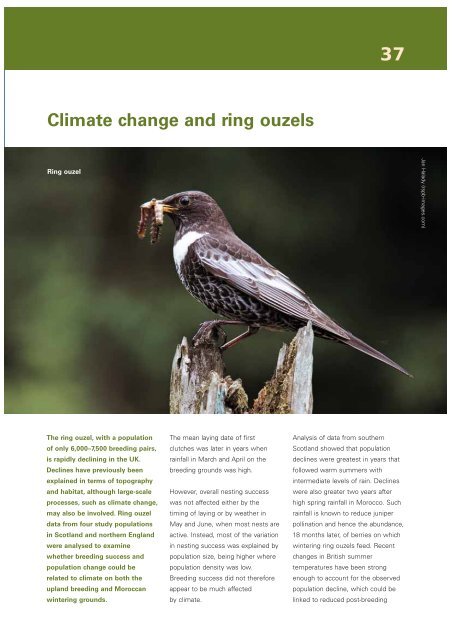Conservation Science in the RSPB 2006
Conservation Science in the RSPB 2006
Conservation Science in the RSPB 2006
Create successful ePaper yourself
Turn your PDF publications into a flip-book with our unique Google optimized e-Paper software.
37<br />
Climate change and r<strong>in</strong>g ouzels<br />
R<strong>in</strong>g ouzel<br />
Jan Halady (rspb-images.com)<br />
The r<strong>in</strong>g ouzel, with a population<br />
of only 6,000–7,500 breed<strong>in</strong>g pairs,<br />
is rapidly decl<strong>in</strong><strong>in</strong>g <strong>in</strong> <strong>the</strong> UK.<br />
Decl<strong>in</strong>es have previously been<br />
expla<strong>in</strong>ed <strong>in</strong> terms of topography<br />
and habitat, although large-scale<br />
processes, such as climate change,<br />
may also be <strong>in</strong>volved. R<strong>in</strong>g ouzel<br />
data from four study populations<br />
<strong>in</strong> Scotland and nor<strong>the</strong>rn England<br />
were analysed to exam<strong>in</strong>e<br />
whe<strong>the</strong>r breed<strong>in</strong>g success and<br />
population change could be<br />
related to climate on both <strong>the</strong><br />
upland breed<strong>in</strong>g and Moroccan<br />
w<strong>in</strong>ter<strong>in</strong>g grounds.<br />
The mean lay<strong>in</strong>g date of first<br />
clutches was later <strong>in</strong> years when<br />
ra<strong>in</strong>fall <strong>in</strong> March and April on <strong>the</strong><br />
breed<strong>in</strong>g grounds was high.<br />
However, overall nest<strong>in</strong>g success<br />
was not affected ei<strong>the</strong>r by <strong>the</strong><br />
tim<strong>in</strong>g of lay<strong>in</strong>g or by wea<strong>the</strong>r <strong>in</strong><br />
May and June, when most nests are<br />
active. Instead, most of <strong>the</strong> variation<br />
<strong>in</strong> nest<strong>in</strong>g success was expla<strong>in</strong>ed by<br />
population size, be<strong>in</strong>g higher where<br />
population density was low.<br />
Breed<strong>in</strong>g success did not <strong>the</strong>refore<br />
appear to be much affected<br />
by climate.<br />
Analysis of data from sou<strong>the</strong>rn<br />
Scotland showed that population<br />
decl<strong>in</strong>es were greatest <strong>in</strong> years that<br />
followed warm summers with<br />
<strong>in</strong>termediate levels of ra<strong>in</strong>. Decl<strong>in</strong>es<br />
were also greater two years after<br />
high spr<strong>in</strong>g ra<strong>in</strong>fall <strong>in</strong> Morocco. Such<br />
ra<strong>in</strong>fall is known to reduce juniper<br />
poll<strong>in</strong>ation and hence <strong>the</strong> abundance,<br />
18 months later, of berries on which<br />
w<strong>in</strong>ter<strong>in</strong>g r<strong>in</strong>g ouzels feed. Recent<br />
changes <strong>in</strong> British summer<br />
temperatures have been strong<br />
enough to account for <strong>the</strong> observed<br />
population decl<strong>in</strong>e, which could be<br />
l<strong>in</strong>ked to reduced post-breed<strong>in</strong>g

















